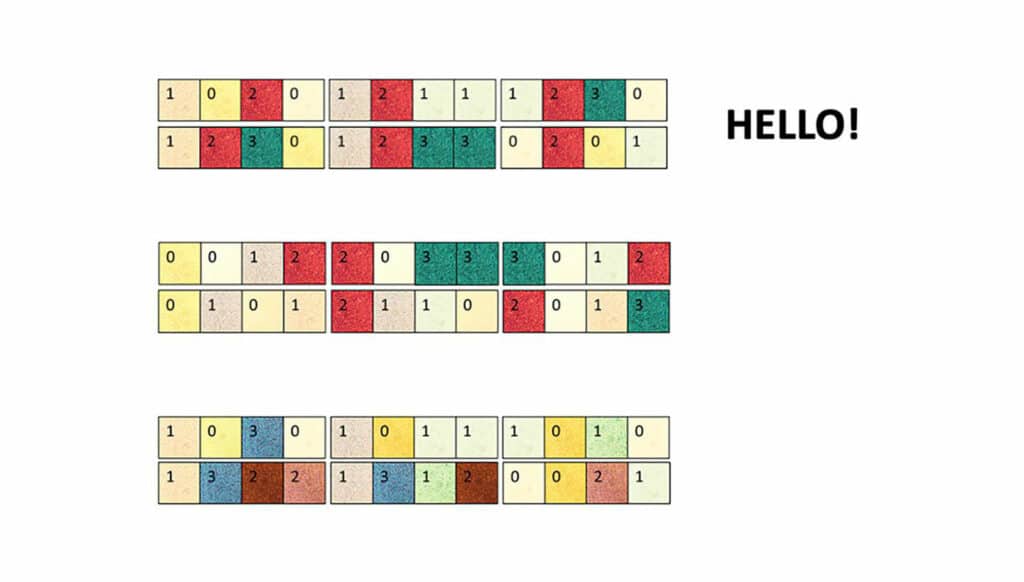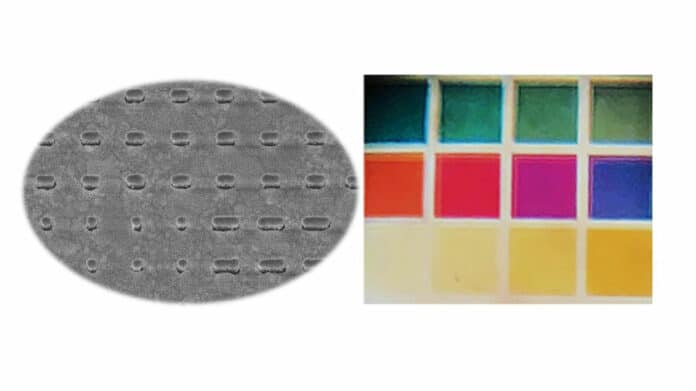In-depth studies have been conducted on the response of simple plasmonic nanorods to polarised illumination. A chiral reaction may happen depending on how that polarisation is oriented to the symmetry axes of the nanostructure. This chiral response can be examined using a second polarizer to regulate the system’s spectrum response.
In a new approach to security that unites technology and art, EPFL researchers have combined silver nanostructures with polarized light to yield a range of brilliant colors, which can be used to encode messages.
Shining polarized light through the nanostructures from specific directions reflects different and easily-identifiable colors. These other colors could be assigned numbers, which could then be used to represent letters using the electronic communication standard code ASCII.
The researchers employed a quaternary code with the digits 0, 1, 2, and 3 to encrypt a message (as opposed to the more commonly used binary codes 0 and 1). The process of chromo-encryption was created as a sequence of four-digit strings made up of various color combinations that could be utilized to spell out a message.
For example, using their system, the color sequence orange, yellow, red, and white represented the digits 1, 0, 2, 0, respectively; a string of numbers which in turn coded for the letter ‘H’ in the secret test message ‘Hello!’.

Olivier Martin, who has been studying the optics of nanostructures for many years as head of the Nanophotonics and Metrology Lab EPFL’s School of Engineering, said, “Each color code is not unique, meaning that the same digit – 0, 1, 2 or 3 – may represent a different color. This means the encryption system is even more secure because the chance of guessing the correct code sequence is smaller.”
The key to this new method is the silver nanostructures’ unusual reaction to polarized light. Variations in the nanostructures’ length and position were first used to create the various colors the researchers saw. They were then exposed to polarised light, which caused the light waves to oscillate in predetermined directions (vertically, horizontally, or diagonally).
The light reflected from the nanostructures varied in polarization from drab to brilliant, producing strong colors that were subsequently passed via a second polarizer for study.
Martin explains, “To our surprise, the nanostructures exhibited what is known as a chiral response, as they reflected the polarized light in a different direction than the excitation itself. In physics and chemistry, chirality – or the properties of a material that arise from its geometric asymmetry – is an important and well-studied functional aspect of molecules like proteins. But it was not expected to be seen in the symmetrical silver nanostructures.”
“Chirality is a concept that is often misused and is difficult to nail down. The fundamental aspect of chirality in simple geometries like those exhibited by our nanostructures is a key finding of this study.”
Along with encoding messages, this method can also be used to reproduce a painting. For testing, scientists produced Picasso’s Mediterranean Landscape – at the nanometer scale. They replaced the pixels of a digital reproduction of the painting with their silver nanostructures. As with the chromo-encryption method, the artwork was only revealed when light polarized in the correct direction was shone onto the “nano-painting.”
Martin says that the method’s combination of nanotechnology with human visual perception has a lot of potential for artistic applications and encryption techniques, such as more secure banknotes.
“Nanomaterials and color are at the crossroads of high-tech and artistry, and I find that very appealing. Using nanostructures, you can encode a huge amount of information into an extremely small area, so there is the potential for very high information density. At the same time, an approach to encryption that can be read and interpreted by the naked human eye, instead of a computer, could be advantageous.”
Journal Reference:
- Wang, H.-C., Martin, O. J. F., Polarization-Controlled Chromo-Encryption. Adv. Optical Mater. 2023, 2202165. DOI: 10.1002/adom.202202165
